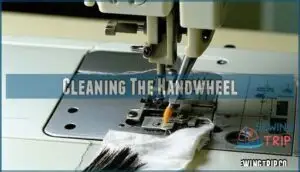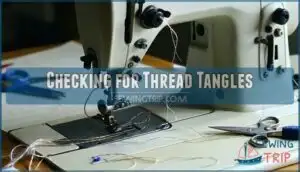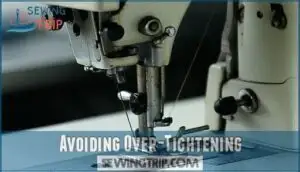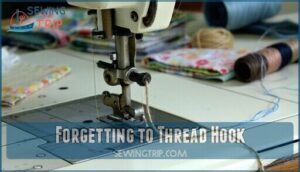This site is supported by our readers. We may earn a commission, at no cost to you, if you purchase through links.
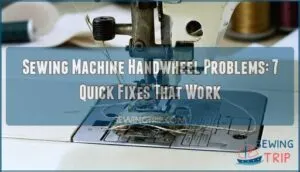
Start by removing the needle plate and clearing any thread nests you find. Next, brush out accumulated lint from around the handwheel assembly.
If it’s still stuck, check the drive belt for cracks or stretching. Sometimes the handwheel gets locked when the machine overheats, so let it cool down completely before trying again.
These quick fixes solve most handwheel headaches, but deeper mechanical issues require different approaches.
Table Of Contents
Key Takeaways
- Start with thread issues first – You’ll solve 90% of handwheel problems by checking for tangled thread beneath the needle plate, around the bobbin case, and in the take-up lever area before trying anything else.
- Clean and lubricate regularly – You can prevent most handwheel stiffness by brushing out lint buildup monthly and applying 1-2 drops of sewing machine oil to the handwheel shaft and moving parts.
- Check your drive belt when the motor runs but nothing moves – You’ll need to remove the side panel to inspect for frayed edges or complete breaks, then replace it with an exact match for proper tension.
- Let overheated machines cool completely before forcing anything – You’ll avoid expensive damage by taking breaks during heavy use and waiting for the machine to return to normal temperature when the handwheel locks up from heat.
Handwheel Problems Causes
When your sewing machine’s handwheel won’t turn or feels stuck, you’re likely dealing with one of four main culprits that can bring your project to a halt.
Understanding these common causes helps you quickly identify what’s wrong and get back to sewing without unnecessary delays, which is crucial for maintaining your project’s momentum.
Thread Jams
Thread jams happen when lint, thread fragments, or tangled material blocks your machine’s thread path. This obstruction prevents smooth thread movement, causing your handwheel to seize up completely.
When threads tangle, your handwheel locks up faster than you can say "seam ripper.
Around 90% of beginner sewing problems stem from threading errors that create these frustrating tangles. Regular thread tension checks can help prevent such issues.
Thread Removal and Jam Prevention steps:
- Clear visible thread tangles from the bobbin case and needle plate area
- Use floss cleaning techniques with tweezers to extract stubborn debris
- Check bobbin clearance – remove and rewind if overfilled or poorly wound
- Inspect the take-up lever area where hidden tangles often lurk
- Re-thread your entire machine following the proper threading sequence
Broken Belt
A broken drive belt will stop your handwheel from turning completely.
You’ll notice the motor runs but nothing moves – that’s your first clue.
Check for frayed edges or complete belt breaks around the motor area.
Belt replacement requires removing the machine’s side panel.
Match the belt materials exactly when ordering replacements.
Proper belt adjustment prevents future handwheel problems and keeps your sewing machine handwheel operating smoothly and with complete functionality.
Lint Buildup
Beyond belt problems, handwheel stuck situations often stem from everyday fiber buildup inside your machine.
Your sewing space becomes a dust magnet, and those tiny fibers sneak into moving parts like uninvited guests.
Lint builds up like snow in a blizzard, clogging every gear and shaft until nothing moves.
Here’s what lint accumulation costs you:
- Handwheel resistance that makes turning feel like wrestling
- Thread tension problems from clogged mechanisms
- Skipped stitches when debris blocks timing
- Motor strain from working harder against fuzz
- Expensive repairs from neglected debris cleaning
Regular lint removal prevents these sewing machine handwheel problems before they start.
Machine Overheating
Your machine can overheat from continuous heavy use, causing handwheel stuck problems.
Motor failure often happens when you push thermal limits too hard. Poor ventilation blocks cooling systems, making overheating worse.
Watch for unusual heat or burning smells – these signal trouble ahead. Take breaks during long sewing sessions to prevent sewing machine overheating and protect your handwheel from heat-related damage, which can be caused by poor maintenance and lead to motor failure.
Handwheel Maintenance Tips
Proper handwheel maintenance keeps your sewing machine running smoothly and prevents costly repairs down the road. Think of it like changing your car’s oil – a little effort now saves major headaches later.
Follow these maintenance schedules to keep your handwheel in peak condition:
- Weekly: Wipe down the handwheel with a dry cloth to remove dust and lint
- Monthly: Apply 1-2 drops of sewing machine oil to the handwheel shaft
- Quarterly: Check handwheel alignment and tighten loose screws
- Bi-annually: Deep clean around the handwheel area with compressed air
- Annually: Have a professional inspect internal mechanisms
Regular cleaning prevents debris from jamming the handwheel’s movement. Oil application keeps metal parts from grinding against each other, which causes wear and stiffness. Check your handwheel alignment by turning it slowly – it should rotate smoothly without wobbling.
These preventive measures cost pennies compared to professional sewing machine handwheel repair. Your maintenance routine doesn’t need to be complicated, but consistency matters more than perfection. Regular handwheel maintenance is key to extending the lifespan of your sewing machine.
Fixing Handwheel Issues
When you’re dealing with a stuck handwheel, you’ll need to tackle the problem systematically to get your machine running smoothly again.
These four essential fixes will help you identify and resolve the most common handwheel issues quickly, and by doing so, you can ensure your machine is operational again.
Cleaning The Handwheel
Your handwheel won’t budge when lint and thread bits turn it into a sticky mess. Start by unplugging your machine and removing the handwheel from its shaft. Use a soft brush to sweep away visible debris, then wipe surfaces with a lint-free cloth.
Check behind the wheel for hidden thread tangles. Regular maintenance also involves addressing lint buildup problems to keep your machine running smoothly.
| Cleaning Step | Tool Needed |
|---|---|
| Remove lint buildup | Soft brush |
| Clear thread tangles | Tweezers |
| Wipe surfaces clean | Lint-free cloth |
This handwheel cleaning process prevents old oil from turning into glue that binds moving parts. Regular maintenance keeps your wheel spinning smoothly.
Lubricating The Handwheel
After cleaning removes debris, apply sewing machine oil to moving parts.
Use the zoom spout for precise Oil Application between gears and shafts.
Different Lubricant Types work, but specialized sewing machine oil prevents lint attraction.
Check your Maintenance Schedules – monthly lubrication prevents handwheel stiffness.
During Gear Inspection, oil visible metal contact points.
Proper sewing machine lubrication keeps your handwheel turning smoothly without forcing it.
Regular maintenance also involves addressing common handwheel issues to guarantee maximal performance.
Checking for Thread Tangles
When thread tangles strike, your handwheel becomes stubborn and refuses to budge. Thread Removal starts with these sewing troubleshooting steps:
- Check the bobbin case area for tangled thread
- Inspect the take-up lever for thread jams
- Remove the needle plate to access hidden tangles
- Clear debris from the hook area thoroughly
Machine Inspection prevents future handwheel issues and keeps your felt cleaning projects running smoothly. Regular use of a thread remover tool is essential for maintaining sewing machine efficiency. This helps in troubleshooting steps to ensure your machine works properly.
Avoiding Over-Tightening
Patience wins the day when dealing with handwheel adjustment. You’ll damage internal components if you force tightening beyond manufacturer specifications.
Check your machine’s manual for proper torque settings.
| Component | Correct Tightness | Signs of Over-Tightening |
|---|---|---|
| Handwheel Screw | Snug, not tight | Handwheel won’t turn smoothly |
| Bobbin Case | Finger-tight only | Thread release becomes difficult |
| Needle Clamp | Firm grip on needle | Handwheel replacement needed early |
Over-tight screws cause handwheel troubleshooting headaches and expensive handwheel maintenance repairs down the road.
Common Handwheel Errors
Sometimes you’ll make simple mistakes that cause your handwheel to jam or stick unexpectedly.
These common user errors are often the easiest problems to fix once you know what to look for, and identifying complete concepts is key to resolving them.
Forgetting to Drop Pressure Foot
You’ve got pressure foot issues when you forget to drop it before sewing.
Over 90% of handwheel problems start here.
When the foot stays up, your tension discs won’t engage properly.
This creates fabric snagging, thread jams, and needle damage that’ll freeze your handwheel mid-stitch.
Always check your foot lifter position first—it’s the quickest fix for most sewing machine errors, often resolving issues related to tension discs and handwheel problems.
Forgetting to Thread Hook
Your machine’s handwheel might stick because you forgot to properly thread the hook area.
This simple oversight creates tension problems that prevent smooth rotation.
When thread doesn’t follow its correct path through the hook timing system, your handwheel fights against misaligned components.
- Hook Alignment becomes compromised when thread bypasses critical threading points
- Thread Tension increases dramatically without proper hook area threading sequence
- Bobbin Issues multiply when the hook can’t catch thread at correct timing intervals
- Sewing Errors cascade from initial threading mistakes in the hook area
Using Wrong Size Bobbins
Wrong bobbins size creates handwheel headaches you don’t need.
Check your bobbin case specifications before loading thread.
Mismatched bobbins cause thread breakage and create bobbin tension problems that jam your handwheel.
Class 15 bobbins won’t fit Class 66 machines properly.
Always verify bobbin compatibility with your model to prevent sewing errors and maintain smooth handwheel operation during projects.
Forgetting to Replace Needle
A dull needle creates friction that can lock your handwheel tight.
You mightn’t realize your needle needs swapping until the handwheel refuses to budge.
Bent or damaged needles jam against fabric, causing sewing machine handwheel issues.
Replace needles every 8-10 hours of sewing for proper handwheel maintenance and machine damage prevention.
Regularly checking for needle change techniques can help prevent these common handwheel problems, ensuring sewing machine efficiency and promoting regular maintenance.
Advanced Handwheel Solutions
When basic fixes don’t work, you’ll need to dig deeper into your machine’s mechanical components.
These advanced solutions require more time and patience, but they can resolve stubborn handwheel problems that simpler methods can’t touch, involving advanced solutions.
Disassembling The Handwheel
When basic fixes fail, handwheel removal becomes necessary.
Unplug your machine first—safety isn’t negotiable. Locate the stop motion screw and turn it counterclockwise.
Remove the handwheel collar using snap ring pliers for screw inspection. Clean the exposed shaft thoroughly, removing old grease and debris.
Check gear alignment before reassembly to prevent future sewing machine handwheel issues. For efficient removal, utilize proper handwheel removal tools to avoid damage.
Checking for Worn-Out Parts
During part inspection, examine gears for chips or excessive wear that signal replacement time. Check shafts for hairline cracks – they’ll snap under pressure.
Worn bearings create grinding sounds and rough handwheel movement. Test each component’s fit and function systematically.
If faulty gears or broken shafts appear, stop immediately to prevent further damage requiring professional sewing machine parts replacement. Regular maintenance is key to preventing common handwheel issues that can lead to costly repairs.
Adjusting Timing and Needle Bar
Improper timing adjustments can turn your handwheel into a stubborn mule.
When needle alignment goes sideways, you’ll need mechanical calibration expertise.
Start by setting bar height precisely – the needle’s eye should sit 2.4mm below the hook point when rising.
This stitch regulation dance requires patience and steady hands for proper sewing machine handwheel maintenance.
Seeking Professional Help
Sometimes you’ll hit a wall that requires professional expertise. When handwheel problems persist despite your best troubleshooting efforts, contact a Brother Authorized Service Center or local sewing machine repair service.
Certified technicians have specialized training for complex timing adjustments and internal gear issues. Don’t let emergency assistance needs derail your projects—professional advice saves time and prevents costly damage.
Frequently Asked Questions (FAQs)
How to fix a sewing machine handwheel?
Fixing frozen handwheels frustrates many sewers, but you’ll conquer this common complication quickly.
Turn handwheel counterclockwise, unplug machine, remove needle plate, clear thread tangles, clean debris, lubricate hook race with sewing machine oil.
Then reassemble components carefully.
Why is my sewing machine handwheel hard to turn?
Thread jams in the bobbin case, needle plate, or take-up lever usually cause handwheel stiffness.
Check for tangled thread, clean out lint buildup, and lubricate moving parts with sewing machine oil.
Why did my sewing machine lock up?
Your machine locked up because something’s jammed inside.
Check for tangled thread in the bobbin area, needle plate, or take-up lever.
Turn off the machine and clear any debris you find.
Why is my Singer 4423 handwheel hard to turn?
Your Singer 4423’s handwheel likely has thread jams in the bobbin case or needle plate area, or internal gears need lubrication after sitting idle too long.
What happens if a sewing machine handwheel is disengaged?
When you disengage your handwheel, the needle won’t move while the machine runs. You can wind bobbins without stitching fabric or accidentally moving the needle position.
What if a handwheel is stuck on a sewing machine?
Well, isn’t it just peachy when your trusty machine decides to throw a tantrum?
Don’t panic – turn off your machine first, then check for thread tangles around the bobbins case and needle plate area.
What is a sewing machine handwheel?
Your handwheel is the large wheel on your machine’s right side that you turn to manually move the needle up and down, controlling stitch timing and positioning.
What causes a hard-to-turn sewing machine handwheel?
Imagine this scenario: you’re ready to sew, but your handwheel feels like it’s stuck in molasses.
Thread jams, dried oil, lint buildup, or hardened grease typically cause this frustrating resistance that’ll stop your project cold, usually due to one of these common issues.
Why won’t the handwheel on my sewing machine turn?
Your machine’s likely jammed with thread tangles around the bobbin case or needle plate. Turn it off, remove the needle plate, check for debris, and re-thread completely before testing again.
How do you fix a stiff hand wheel on a sewing machine?
Like loosening a rusty bolt, you’ll need to tackle this methodically.
First, unplug your machine and remove the needle plate and bobbin case.
Check for thread tangles underneath, then apply sewing machine oil to the hook race and moving parts.
Clean out any lint buildup, ensuring the machine is properly maintained with regular checks.
Conclusion
Don’t throw in the towel when your handwheel gets stubborn.
Most sewing machine handwheel problems stem from simple issues you can fix yourself.
Clean out thread tangles, brush away lint buildup, and check your drive belt condition.
Remember to let overheated machines cool down completely.
With proper maintenance and these troubleshooting steps, you’ll keep your handwheel spinning smoothly for years of successful sewing projects, ensuring successful sewing.
- https://www.reddit.com/r/sewhelp/comments/pvwhs7/why_is_the_wheel_turning_but_not_the_needle/
- https://www.youtube.com/watch?v=v-yQZxfsezo
- https://www.threadsmagazine.com/forum/sewing-machine-hand-wheel-stuck
- https://blog.ricoma.com/2024/06/24/why-is-my-sewing-machine-jamming/
- https://www.thriftyfun.com/Repairing-Handwheel-on-a-Singer-Sewing-Machine.html


